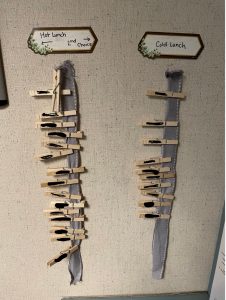Student Contributor: K. Wittkopp
 For this tool, there are two ribbons stapled to the wall with the labels “Hot Lunch” and Cold Lunch.” When students come in at the beginning of the day, they place the clothespin with their name on it on the ribbon that correlates with what they will be having for lunch that day. This shows the teacher who is at school, who is absent, and what each student is having for lunch so both attendance and lunch counts can be submitted.
For this tool, there are two ribbons stapled to the wall with the labels “Hot Lunch” and Cold Lunch.” When students come in at the beginning of the day, they place the clothespin with their name on it on the ribbon that correlates with what they will be having for lunch that day. This shows the teacher who is at school, who is absent, and what each student is having for lunch so both attendance and lunch counts can be submitted.
This tool should only be used at the very beginning of the day since it is for attendance. The routine that students should follow is as soon as they come in, drop their things off at their desk and go check in with their clothespin. An important element to keep in mind is the placement of the ribbons. They should be in a spot in the room that is easily accessible to students. My mentor teacher uses this tool in her classroom every morning. The students come in, drop their backpacks off, get out any homework they had, then go to check in for attendance/lunch. After about two weeks of using this tool, it has become a habit for all the students. Every day is different, and for the crazier mornings students may need one or two reminders to check in, but overall, they are all very good about remembering to check in.
I placed this tool in the preventative phase because it prevents students from being missed during attendance and lunch counts. It is not necessarily a tool for monitoring behavior, it is more for students to learn responsibility. In relation to the supportive phase, it helps students learn to be independent. I do not feel that this tool relates to the corrective phase, because it is never used to correct any sort of behavior in the classroom. The theory of influence I feel this tool best aligns with the referent theory. I think this because this tool is all about giving power to the students, and the referent authority base falls on the student-centered side of the continuum. The teacher also establishes this routine with students and asks for input from them to see if there is a better place in the room for it.
More Information –
Tool Source: Mentor Teacher


